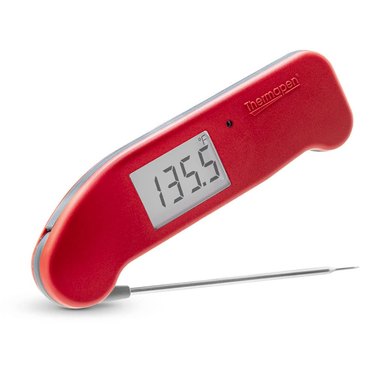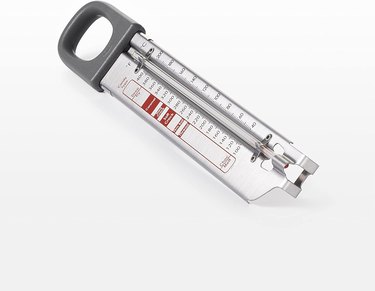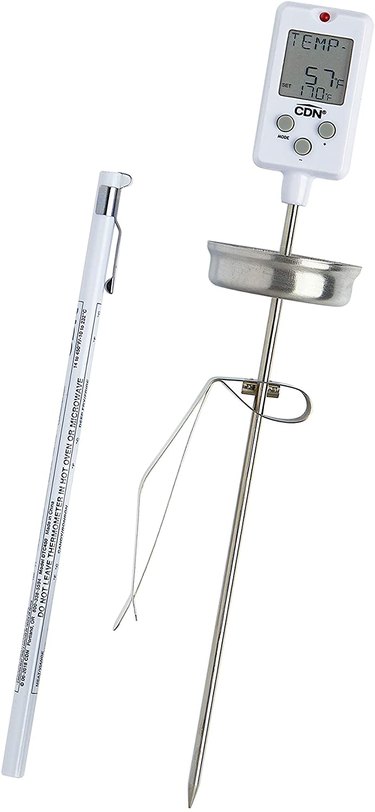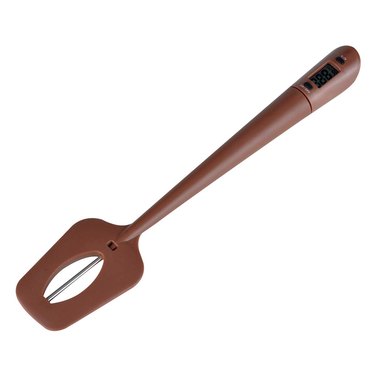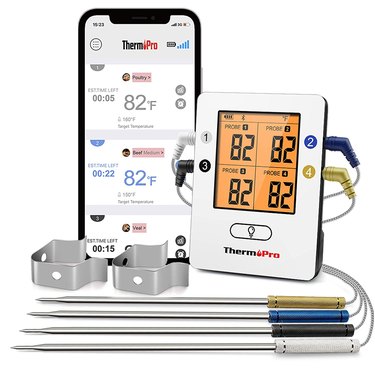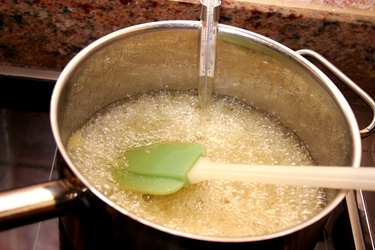
It's certainly not hard to find candy in stores. So why would you make your own at home? There are actually many reasons. Maybe you've found one of your grandma's recipes in an old notebook, and you're trying to resurrect a family favorite. Maybe you want to enjoy artisanal sweets without the hefty price tag, or maybe you just want to challenge yourself to try something different in the kitchen.
Whatever your motivation, making candy involves heating sugar to very specific temperatures. Back in the day, people worked by eyeball and guess work: They dropped the sugar into a glass of cold water and judged its degree of doneness by texture ("soft ball," "soft crack," "hard crack" and so on). It works, once you've gained enough experience, but it's much, much easier to simply get a good candy thermometer. So, what makes a thermometer good? Well, we have some thoughts.
Video of the Day
Video of the Day
A Couple of Points About Thermometers
Before we get into a discussion about the thermometers themselves, there are a couple of things that are helpful to know for context:
Candy Thermometer Versus Meat Thermometer: If you've already shelled out for a perfectly good meat thermometer, can you double down by using it for candy-making as well? The most accurate answer is "sometimes, but usually not." Meat thermometers generally won't go far above the boiling point of water, because meat cooked past that point is a very sad thing indeed. Unfortunately, most candy-making takes place at temperatures well above that mark: Candy thermometers (and deep-fry thermometers; you can use a candy thermometer for deep frying or vice-versa) typically top out at well over 400 degrees Fahrenheit. A few high-end thermometers can do both, but they're rare.
How to Calibrate a Candy Thermometer: Aside from a few high-end digital models with reliable thermocouples, most candy thermometers may not remain accurate. To calibrate one, attach it to a pot full of water and let it boil for 10 minutes. If it reads 212 degrees Fahrenheit (at sea level), you're good to go, but if it's off ,you'll need to record that difference and adjust (calibrate) your recipes accordingly. If it reads 10 degrees too low, for example, you'd know that your thermometer will show 320 degrees Fahrenheit when your sugar is actually at 330 degrees. Dial-type thermometers and some digital thermometers can be manually calibrated so they'll show the correct temperature, which makes for a lot less mental math.
How to Use a Candy Thermometer: The mechanics of it are pretty simple: Clip on your thermometer if it's a clip-on type, and heat your sugar mixture (for probe-type thermometers, dip the probe into the sugar mix at regular intervals). Make a mental note of the target temperature on your thermometer's face or dial—some models have a sliding marker you can use to give a visual reference—and turn down the heat under your pot as you get closer to the target temperature. Once you've reached the desired temperature point, remove your pot from the heat and set it in a shallow pan of cold water to stop the sugar from cooking any further. Wash and dry the thermometer immediately in order to prevent sugar from sticking and hardening.
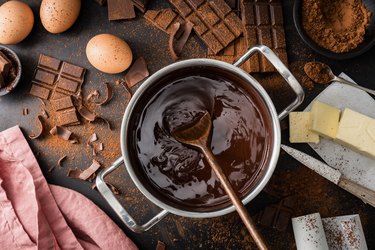
What to Consider When Purchasing a Candy Thermometer
Basic Design: There are a handful of common types of candy thermometer. One is the bulb type, which is a simple glass cylinder that tapers to a point (like a fat pencil) and then has a bulb at the bottom. They're cheap, but hard to read and easy to break. Others have a narrow analog thermometer mounted into a metal frame, which improves both readability and durability. Their main downside is that they have lots of seams and crevices, and sugar trapped in those seams can make your whole batch crystallize and fail. A third type uses a long, narrow metal probe and shows the temperature on a dial at the top. Digital thermometers are almost always the probe type.
Analog Versus Digital: Digital thermometers sometimes resemble the dial type, but feature a digital display rather than the analog dial. They might also have a clip-on probe wired to a separate digital display, or be an all-in-one style—like an instant-read meat thermometer—with the display on one side of the body. Those don't clip in place on the pot (electronics don't play nicely with heat and steam), but must be held in the sugar mixture while you take your temperature reading. Digital thermometers offer great readability and high accuracy, but their electronics can fail, and inevitably, a day will come when the battery dies while you're in the middle of a batch.
Readability: Even the most accurate thermometer won't help your candy-making if you can't read what it says. Ideally, the numbers should be large and legible (and not wear off with use), whether your thermometer is analog or digital. Digital models have an advantage overall, but a well-made analog thermometer has its pluses, as well. They'll often have the old-school "soft ball" and "hard crack" stages marked and be color coded on their face, which makes it easier to work with old-school recipes, and also helps you get a feel for when to reduce heat to the pot.
Speed: Analog thermometers tend to lag behind the true temperature by a few degrees, just because of physics (you'll learn to compensate, but it's a learning curve). A good digital thermometer can be much faster, which—with exacting recipes—can be crucial. In candy-making, a difference of just a degree or two can utterly change the texture of your finished confection, and a fast digital thermometer can help you nail those fine differences consistently.
With these considerations in mind, we've selected the best candy thermometers on the market in 2022:
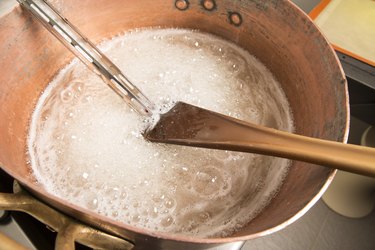
The Best Overall Digital Candy Thermometer
ThermoWorks Thermapen One
Despite what we said earlier about candy thermometers versus meat thermometers, our top choice for both categories is the same: ThermoWorks' Thermapen One. It will read up to 572 degrees Fahrenheit—more than enough for candy-making—nd it's accurate to within 1/2 degree F.ahrenheit. Its only shortcoming is that you'll need to manually hold it over the cooking sugar to get a reading, but it's very fast (1 to 3 seconds), so you won't need to hold it for very long, and you can always use an Ove-glove to protect your hand. The upside to this approach is that a clipped-on thermometer only reads the temperature in one spot, and few stoves (or pots) heat evenly. Taking readings in various areas of the pot gives you a better feel for how your candy is progressing.
The Thermapen commands a premium price, but it's a superbly capable device (with a five-year warranty), and its versatility means you won't need a separate thermometer solely for your candy-making.
The Best Overall Analog Candy Thermometer
OXO Good Grips Glass Candy and Deep Fry Thermometer
It's really neck-and-neck in this category between the OXO model and the corresponding Polder thermometer which is also a really well-made tool at a near-identical price point. It's the fine details that give the OXO model its edge (unsurprisingly, because that's what the brand is built on). Both have a stay-cool grip at the top, which you can use to lift out the thermometer by hand or with a utensil, and both are quite legible.
The OXO model's design is smoother and offers fewer crevices where sugar can get stuck, and—while both mark their thermometers with old-school firm ball- and soft crack-style temperature ranges—the OXO model does this in a large, legible sidebar alongside the main markings. Its oversized clip also makes it a comfortable fit for a wider range of pot sizes and shapes, which is especially helpful for small batches. You can't go wrong with either thermometer, but the OXO model is just a little bit better thought out.
The Best Long-Probe Candy Thermometer
CDN DTC450 Digital Candy/Deep Fry Thermometer
What's the point of a long-probe candy thermometer? Well, there are a few. First, it means you can use a taller, deeper pot. It also keeps the electronics farther away from the circuit-destroying heat and humidity of the pot. Plus, it raises the display up from the steam where it's easier to see. If you're using the thermometer in your hands, instead of clipped to the pot, you'll keep your hand farther from the heat source, as well.
This model from CDN—a respected manufacturer of scales, thermometers and timers—checks all of those boxes, and adds a couple of other nice details, as well. The clip is adjustable to the height of your pot, for one, and there's also a splash guard to protect the screen and electronics of the display (and your fingers, if you're holding it) from splatters of hot sugar. All told, it's a solid, all-round value at a very reasonable price.
The Best Special-Purpose Candy Thermometer
Lightbeam Silicone Spatula/Digital Candy Thermometer
Not all candy- and dessert-making requires stirring—with sugar work, it's often a no-no, anyway—but a lot of the time, it will. Whether you're making sure your caramel doesn't stick and scorch, or stirring a cooked meringue as it heats, this combination of candy thermometer and silicone spatula is exactly the tool for the job. It's a fairly standard-issue instant-read thermometer for the most part, except it accommodates candy-making temperatures (up to 572 degrees Fahrenheit) and has an extra-long probe.
When you're using it as a spatula, the probe fits into a slot in the spatula's blade where it will take ongoing temperature readings as you stir. When you're done, it comes apart for cleaning. You can also use the thermometer on its own, for those moments when you don't need to stir, but still want to check the temperatures. The extra-long probe means you can keep your hand away from the heat while you do it, which is a definite plus.
The Best Smart Candy Thermometer
ThermoPro TP25 Bluetooth Thermometer
Like our top-choice, theThermoWorks thermometer, this one from ThermoPro is a versatile all-rounder that's just as good for candy-making as it is for grilling and barbecuing. The unit comes with four probes, which—while admittedly more useful for grilling—is handy for those times when your candy-making involves two pots, or when you've got a roast in the oven and caramel going on the stovetop.
The "smart" part comes by way of the accompanying app: The thermometer pairs with your smartphone and will transmit to it from up to 500 feet away using Bluetooth 5. The app is smart enough to warn you when you get within 5, 10 or 15 degrees of your target temperature, so you can use some of your attention for other things during the early stages of your candy-making. The app will even give you an estimated time to reach your target temperature, which is a great convenience.
